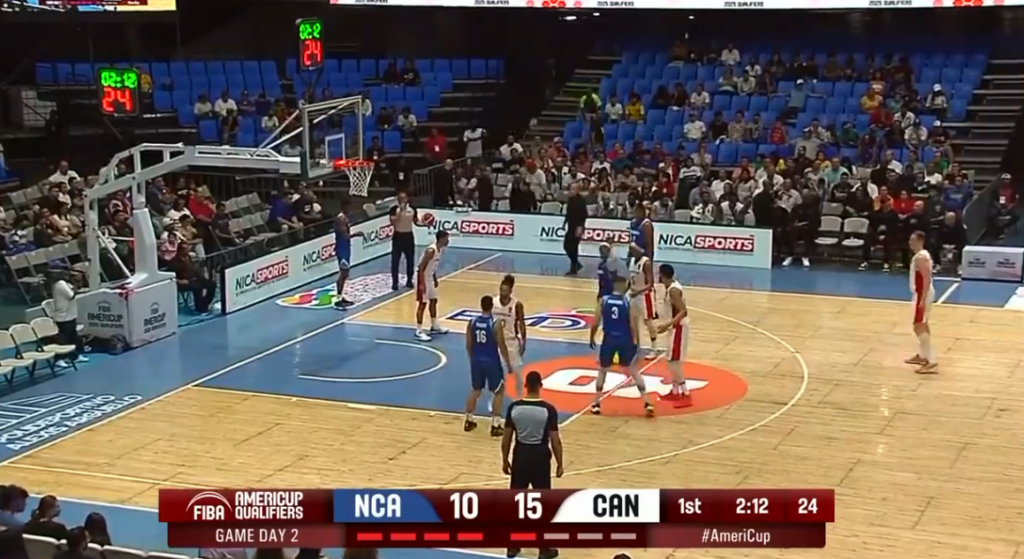We’re only a few months away from the 2024 Paris Olympic Games, where all eyes will be on Canada’s “Summer Core”. But before any of my preview coverage for this monumental summer for Canada Basketball begins, I wanted to take it back to Window 1 of the 2025 AmeriCup Qualifiers.
Back in February of 2024, Canada’s “Winter Core” took care of business with two easygoing victories over Nicaragua, the hosts of the 2025 AmeriCup. Canada trailed for just 3:51 of game time, with their largest deficit over the window being a mere 6 points. In fact, the two games against Nicaragua were so uncompetitive that head coach Nate Bjorkgren only had to call 1 timeout in total.
While this qualifying window doesn’t generate the same amount of buzz as the Olympics (or even the World Cup for that matter), it was still notable to me because it was the first time Nate Bjorkgren was head coach of the SMNT since Nick Nurse’s departure. Over Nurse’s tenure with Canada Basketball, it was Nate Bjorkgren who was a lead assistant coach in the summers and took over head coaching duties during the winter qualifying windows that overlapped with the NBA season. As the head coach, Bjorkgren and the “Winter Core” have become a FIBA Americas powerhouse, with an impressive 9-1 record since 2021. Developing continuity has been the priority for Canada Basketball this Olympic cycle (that’s the whole point of the two “Cores”) and Nurse and Bjorkgren did their best to establish coherent offensive and defensive identities for the National Team. As someone who re-watched and hand-tracked every SMNT offensive possession over the Nurse tenure (2019-2022), I can honestly say they did a good job of implementing a consistent offensive scheme across different iterations, windows and rosters.
How have things changed now that Canada Basketball is in the Jordi Fernandez era? The good news is, not too much! Nate Bjorkgren continues to be the pillar of continuity and it’s clear that he’s sprinkled in actions and schemes from both Nurse and Fernandez in the first 2025 AmeriCup Qualifier window. Let’s dive into some of his playcalls and decisions against Nicaragua!
Offensive Schemes
Against Nicaragua, Canada mainly played in a “4-Out” alignment in the halfcourt. Given that Canada’s rotation of C’s (Kalif Young and Thomas Kennedy) this window are not strong shooters this is a smart decision to keep them closer to the basket where they are at least a threat to score. To put it into perspective Canada spent only 4:02 over the 2 games without one of Young or Kennedy on the floor, so there was quite a bit of “4-Out” offense, at least when Canada was not running in transition.
What I really liked about Bjorkgren’s playcalling this window was how many of his actions flowed together harmoniously out of the “4-Out” alignment. For example, he would use a quickhitting action (“4 Flip”) that would flow into more slower-paced actions (“UCLA Empty”, “Point Away”, etc.) if the initial options were contained by the defense. Don’t worry if this all sounds convoluted, I’ll break down each step into detail below.
The Quickhitter: “4 Flip”
This “4 Flip” action has been a Nick Nurse staple for years. Nurse’s pet play is a quick flip or DHO at the top to a strong driving wing (think Pascal Siakam) in order to get them moving downhill with momentum. If you’ve watched any amount of Raptors basketball since 2018, I am certain you’ve seen this quickhitter many times.
Back when Nurse was head coach of Canada Basketball, he also went to “4 Flip” during the 2021 Olympic Qualifying Tournament in Victoria. This time around, it was run primarily for RJ Barrett to get to his dominant left hand.
With this edition of the SMNT, Nate Bjorkgren ran “4 Flip” primarily for Jackson Rowe, whose had a strong 1st season in the NBA G-League with the Santa Cruz Warriors. Notice the “4-Out” alignment, with Kalif Young (the C) in the weakside dunker spot!

At 6’7″, 210 lbs and with good movement skills and coordination, Rowe was the logical option to design this quickhitter for, given Canada’s roster construction. Like Siakam, “4 Flip” was run to get Rowe downhill to his right hand. Unfortunately, Rowe isn’t as dynamic as Siakam with the ball in his hands (not many players are at that size) so this action was not as effective. Still, against a lower ranked opponent like Nicaragua, it did its job.
Bjorkgren even went as far as running one of Nurse’s favourite wrinkles out of this quickhitter. Rather than take the ball all the way to the rim, Rowe instead flattens out his drive and hands the ball off to a teammate in the strongside corner. After the second handoff, the ball ends up being swung back up to the player up top, who then receives a step-up screen from the big in the dunker spot. This is a great variation especially if teams begin to overhelp and expect the drive to the rim from the “4” receiving the DHO. Keen eyes will see that this is the same action from the Toronto Raptors playbook video above (1:31).
“UCLA Empty”
Before diving into this action, I again wanted to highlight the “4-Out” alignment from the Canadian offense. Notice though that this time the C (Kalif Young) is near the elbow, rather than in the dunker spot like in the “4 Flip” set.

Canada set up this action with a quick handoff in the opposite wing, before swinging the ball back up top. From there, the ball is swung to the near wing and the passer receives a “UCLA” screen. Theoretically, the first option is to hit this player as he cuts to the basket, but Nicaragua did a good job of defending the initial screen by switching it in this window. After setting the “UCLA” screen, the next progression has the big then flow into an “Empty” PnR.
Moving forward, this wrinkle of adding the popular “Spain PnR” action after the UCLA screen instead of flowing into an “Empty PnR” is a nasty variation that could catch teams who have scouted Canada’s offense in depth off guard. Given that it’s run in the same “4-Out” alignment, it should be easy to integrate within the offense. Having the player who receives the “UCLA” screen come back and set the second screen, essentially blindsiding the opposing big is well disguised and designed playcalling.
“Point Away”
While “4 Flip” was the action Bjorkgren borrowed from Nurse’s playbook, the “Point Away” action comes directly from Fernandez’s 2023 FIBA WC “playbook “Point Series”. This was one of Canada’s go-to pet plays throughout the Bronze medal campaign and I’ve clipped the majority of the different variations and wrinkles Jordi had drawn up.
If you look at the screenshot below, you’ll see again Canada playing “4-Out”, with the exact same alignment as the “UCLA Empty” action! This time around though, the ball actually enters the elbow instead of the near corner/wing.

Against Nicaragua, Canada mainly went to “Point Away” from Jordi’s playbook, where the player who passes the ball into the pinch post (elbow) follows his pass and goes “over” to run some 3-man action in the corner. The most frequent 3-man action from the SMNT was “Zoom” (a pindown into a DHO), though the players had plenty of freedom to read and react to what the defense was doing. Moving forward, there’s a lot of different 3-man actions that Canada can go to from this alignment that can bring more versatility and unpredictability to Fernandez/Bjorkgren’s play calling.
One particular wrinkle I did want to highlight was what I call “Point Series Reverse”. Once opposing defenses are used to the ball entering the elbow, Bjorkgren throws a curveball and has Canada reverse the ball back to the player at the opposite wing/slot, who immediately attacks off the catch. It’s a good variation to use especially if the opposing defender at the opposite wing/slot starts to cheat too much towards the elbow, putting themselves out of position for the eventual reverse pass and drive.
Putting Everything Together
Now that we have a basic understanding of the quickhitter (“4 Flip”) and the two more involved actions (“UCLA Empty” and “Point Away”), it’s finally time to talk about what made Bjorkgren’s play calling especially impressive to me in the first AmeriCup Qualifier Window. With each of these 3 actions under the “4-Out” offensive scheme, Bjorkgren was able to have Canada start with “4 Flip” before flowing into either “UCLA Empty” or “Point Away”, stacking multiple actions together within the same offensive possession.
Why is this possible? Well it all goes back to the shared starting alignment of “UCLA Empty” and “Point Away”. Since both actions have the same initial spacing, they are almost completely interchangeable. Bjorkgren is free to “plug-and-play” and experiment with new combinations of actions in the playbook, making Canada’s offense more unpredictable and complex for opposing defenses to scout and defend. You can think of these individual actions as puzzle pieces, with its shape representing the initial alignment. As long as the pieces fit (alignments match), you can attach pieces together. Now the puzzle analogy can’t capture the interchangeable nature of actions with the same alignment, but hopefully it helps with appreciating the layers of well-planned strategy from the SMNT’s offensive system.

Defensive Coverages
If I could describe Canada’s defense in Window 1 in one word it would be unrelenting. They held Nicaragua to just 32.4% shooting (35/108) overall from the field and below 100 points combined in the two games. With Nicaragua’s lack of premier ball handling talent at the guard positions, Canada was ultra aggressive defensively. Bjorkgren had the SMNT pick up full court, sometimes even going as far as bringing all 5 Canadians into the Nicaraguan back court to matchup and press in the 1st quarter.

Bjorkgren ruthlessly exploited one of Nicaragua’s most glaring weaknesses and it paid off big time. Not only did the pressure totally disrupt the Nicaraguan offense, leading to a total of 53 turnovers over the two games in the window, Canada also converted those turnovers into a whopping 50 points in transition, powering their offense in the absence of an elite halfcourt creator.
When Nicaragua did laboriously get into their halfcourt offense, Canada’s defensive continuity and chemistry thrived. Take this defensive stand below as an example. Rowe gets beat on the perimeter, but Trae Bell-Haynes rotates to stop the layup. Aaron Best and Phil Scrubb then rotate perfectly to “help the helper” and it’s 1 errant pass before Canada is back in its defensive shell. Kadre Gray fights hard to front the post and deny the mismatch inside and Canada forces the turnover. Beautiful execution on defense.
Bjorkgren also followed a growing trend in the NBA of playing zone to defend BLOB (BaseLine Out of Bounds) actions. Much like Nurse, Bjorkgren defense is quite unpredictable and he’s not afraid to mix things up to throw off opposing offenses.
Looking to the Future – Jackson Rowe at the 5?
While Canada predominantly played “4-Out” this window, there was a 4 minutes stretch in the first game where Bjorkgren experimented with going small, putting Jackson Rowe at the 5. And it wasn’t by necessity as both Kennedy and Young were not in foul trouble in the 2nd quarter when the lineup change occurred.
In the 4:02 that Rowe was at the 5, Canada was a -1 overall. Small sample size, but what was interesting was how Canada’s offense changed. Going from “4-Out” to “5-Out” alignment, the SMNT had much more spacing to operate with. Here’s an example of “Delay Zoom” action, or as Bjorkgren calls it “5 Backside”.
Moving forward, I think minutes with Rowe at the 5 is something that should continue to be explored. Not only does it create more spacing and give Canada more offensive creation at all positions, it also allows Canada to go to automatic defensive coverages like switch everything. Canada’s next opponents are the Dominican Republic and Mexico, who both don’t have ridiculously huge frontcourts, so maybe Bjorkgren will find an opportunity to squeeze in this lineup.



